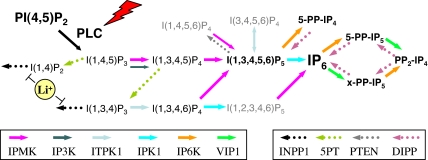Fig. 1.
Six classes of evolutionarily conserved IPKs generate an IP code in mammalian cells: (i) IPMK (also known as IPK2 or ARG82), a multikinase capable of producing I(1,3,4,5,6)P5 through the dual phosphorylation I(1,4,5)P3 at the 3- and 6-kinase positions, as well as through a 5-kinase activity toward I(1,3,4,6)P4; (ii) IPK1, an IP5 2-kinase responsible for the generation of IP6; (iii) IP3K, a selective IP3 3-kinase that produces I(1,3,4,5)P4 from I(1,4,5)P3; (iv) ITPK1 (also known as IP56K), an I(1,3,4)P3 5- and 6-kinase capable of producing I(1,3,4,6)P4 and I(1,3,4,5)P4, and a reversible 1-kinase/phosphatase that regulates I(3,4,5,6)P4 levels; (v) IP6K/IHPK, an IP5 /IP6 /IP7 5-kinase that generates diphosphoinositol phosphates (also known as PP-IPs), including 5-PP-IP4 and 5-PP-IP5; and (vi) VIP1, an IP6 /IP7 kinase that generates a unique species of PP-IP5 (x-PP-IP5) and (PP)2-IP4 (IP8). In addition, the action of four IPs are relevant to this pathway: (i) INPP1, a lithium-inhibited I(1,4)P2/I(1,3,4)P3 1-phosphatase; (ii) 5PT, an I(1,4,5)P3/I(1,3,4,5)P4 5-phosphatase; (iii) PTEN, a phosphoinositide 3-phosphatase that also has been shown to dephosphorylate IP5; and (iv) DIPP, which degrades PP-IPs. The lightning bolt represents GPCR and RTK pathways that activate PLC isoforms; the yellow sphere represents lithium, a pharmacological agent used to inhibit INPP1. Legend for colored arrows indicates the six kinase (solid) and four phosphatase (dotted) enzymes.

